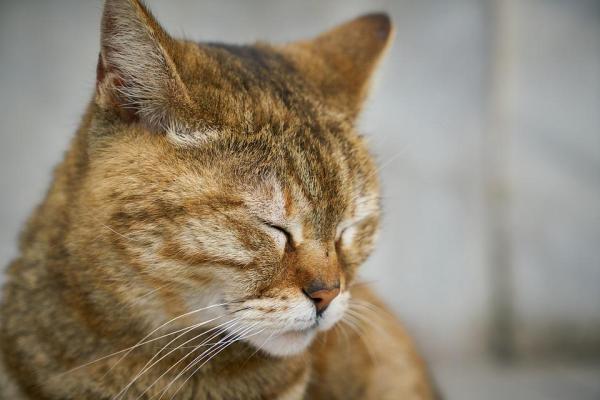Feline Rhinotracheitis



See files for Cats
Feline infectious rhinotracheitis is a very serious and highly contagious disease that affects a cat's respiratory system. This infection is caused by the Herpesvirus Feline 1 (HVF-1) virus and generally affects cats with a low immunity.
When the infection is acute, the prognosis is rather reserved. On the other hand, chronic cases, or prognosis is favorable.
This AnimalWised article will explain all you need to know about feline rhinotracheitis caused by feline herpesvirus! Keep on reading!
Type 1 feline herpes
Feline Herpesvirus 1 (HVF-1) is a virus belonging to the Varicellovirus genus that affects both domestic cats and other wlid cats[1].
This virus contains a double strand of DNA and has a glycoprotein-lipidic envelope. This is why it is relatively fragile in the external environment and is highly susceptible to the effects of common disinfecting agents. For this reason, it is very important to clean and disinfect your cat's home and objects!
This virus manages to survive up to just 18 hours in a humid environment. It hardly survives in dry environments! Thus, this virus usually affects the ocular, nasal and oral regions. It needs this unique environment to survive and these regions are perfect for him!
Feline herpesvirus 1 transmission
The most common form of transmission of this virus is through direct contact between infected cats and cats with low immunity (especially filthy cats). When the cats are born, they have maternal antibodies that protect them more and, as they grow, they lose this protection and become highly subservient to this and other viruses. The importance of vacations is vital!
Symptoms of feline herpes
Feline herpesvirus 1, generally speaking affects a cat's upper respiratory tract. The incubation period of the virus is 2 to 6 days (the time passed since the cat is infected until they show the first clinical signs) and intensity of symptoms can vary.
The main symptoms of the virus are:
- Depression
- Sneezing
- Lethargy
- Nasal discharge
- Eye discharge
- Eye discharge
- Eye injuries
- Fever
With eye lesions, the most common are:
- Conjuctivitis
- Wax
- Proliferative keratoconjunctivitis
- Dry keratoconjunctivitis
- Neonatal ophthalmia
- Siblepharo
- Uvetis

Feline infectious rhinotracheitis
Feline viral rhinotracheitis is caused by infection with type 1 feline herpesvirus, as explained above. This condition affects the youngest mostly, and it can even lead to death. Unfortunately, it is one of the most common diseases in cats.
Diagnosis
Generally, the diagnosis is made by observing the clinical syndromes associated with the presence of feline herpesvirus type 1, referred to above. In other words, the veterinarian makes this diagnosis mainly by observing the symptoms and the cat's history.
If the vet has any doubts, there are laboratory tests that allow an exact diagnosis of this case. Some of the tests are:
- Tissue scrapings for an histopathological exam
- Nasal and ocular swab
- Cell culture
- Immunofluorescence
- PCR (most specific method of all of them)
Does feline rhinotracheitis have a cure?
If rhinotracheitis is cured, it is obviously one of the questions that most worries cat owners when their pet is suffering from this disease. Unfortunately, there is no possibility of cure for acute feline herpesvirus infection in all cats. Especially in kittens, this disease can be fatal. However, there is a treatment and cats with this disease can have a good prognosis if treatment is started in the initial state of the disease.
Feline rhinotracheitis - treatment
After a diagnosis is made, the veterinarian will prescribe appropriate treatment for the cat's clinical signs. Antiviral treatment is a very complicated and time-consuming treatment since the virus lives inside the cells and it is necessary to medicate the cat to prevent the reproduction of the virus without killing the cells where it is housed. For this purpose, the veterinarian may use antiviral agents such as ganciclovir and cidofovir, which have been shown to be effective in combating this virus [2]. In addition, the use of antibiotics is common, since secondary bacterial infections are very common. According to the cat's clinical signs, eye drops, nasal decongestants and nebulizations may be prescribed. More severe cases in which the cats are very dehydratedand/or anorexic may require hospitalization, fluid therapy and even forced feeding through a catheter.
Feline rhinotracheitis - vaccination
The best way to prevent feline rhinotracheitis is undoubtedly vaccination. This vaccine exists in most countries and is part of the normal vaccination plan for cats.
The first dose of the vaccine is usually applied between 45 and 60 days of the cat's life of the animal and the reinforcement should be annual. However, it may vary according to the protocol your veterinarian follows. The most important thing is that you set the vaccination plan that your veterinarian has defined.
Kittens that are not yet vaccinated should avoid contact with unknown cats since they may be carriers of this virus and if it is active they can transmit it. Sometimes the signs of the disease are very mild and are not easy to detect, especially in chronic carriers of the virus.

Can feline rhinotracheitis affect humans?
Because it is a contagious disease and there is also human herpesvirus i, many people ask the question: does feline rhinotracheitis affect humans? The answer is no! You can rest assured that this virus is specific to these animals and cannot be transmitted to us humans. It is highly contagious but only between cats and through direct contact with the secretions of their eyes or nose. Or also, by indirect contact, such as through a sneeze!
We remind you that these animals, even after they have cured their symptoms, are carriers of the virus, which being latent is not contagious. However, once the virus is activated, it is again a potential contagion source.
This article is purely informative. AnimalWised does not have the authority to prescribe any veterinary treatment or create a diagnosis. We invite you to take your pet to the veterinarian if they are suffering from any condition or pain.
If you want to read similar articles to Feline Rhinotracheitis, we recommend you visit our Infectious diseases category.
Tips
- Assim que você notar que o seu gato tem algum dos sinais descritos, visite de imediato um Médico Veterinário.
- Você jamais deve medicar um gato sem prescrição e supervisionamento do seu Médico Veterinário.
- Daniels, M. J. Golder. M. C. Jarrett, O. MacDonald. D.W (1999) Feline viruses in wild-cats from Scotland. 35. 121-124
- Sandmeyer L.S., Keller C.B., Bienzle D. (2005) Effects of cidofovir on cell death and replication of feline herpesvirus-1 in cultured feline corneal epithelial cells. Am. J. Vet. Res. 66:217–222.







